Early Days
My first serious interest in the past developed when I was at school in Sussex. In those days it was archaeology rather than palaeontology, and I found much relief from the pressures of life in a minor public school in exploring the surrounding countryside looking for evidence of Mesolithic man in the area.  I developed a talent for spotting the tiny worked flint characteristic of the period, microliths the size of a fingernail and discovered several new sites, probably the debris from hunting parties in the valley of the Ouse, a much greater river at the end of the last ice age than the stream that flows through the Weald of Sussex today. Although my school was only a few miles from Cuckfield, where Gideon Mantel found the first Iguanodon remains, I knew nothing of its' significance. Interest in a subject is usually sparked by individuals with an enthusiasm, or through wanting to find out more about something picked up by chance. In my case it was a schoolteacher who was also a keen archaeologist. I became one of the few pupils in the country to take a 'A' level in archaeology.
I developed a talent for spotting the tiny worked flint characteristic of the period, microliths the size of a fingernail and discovered several new sites, probably the debris from hunting parties in the valley of the Ouse, a much greater river at the end of the last ice age than the stream that flows through the Weald of Sussex today. Although my school was only a few miles from Cuckfield, where Gideon Mantel found the first Iguanodon remains, I knew nothing of its' significance. Interest in a subject is usually sparked by individuals with an enthusiasm, or through wanting to find out more about something picked up by chance. In my case it was a schoolteacher who was also a keen archaeologist. I became one of the few pupils in the country to take a 'A' level in archaeology.
Shurlock Row
For various reasons I decided not to pursue archaeology as a career, and studied architecture at university (or polytechnic as it was in those days). At the time my parents had just moved back to England from Belgium, and found a house in a village called Shurlock Row, near Reading in Berkshire. I had visited friends in Somerset, and picked up an ammonite on the foreshore near Watchet - a crushed specimen I wouldn't bother with today.  I was fascinated by the geometrical shape of the spiral, and the sense of holding in my hand something millions of years old, and unlike anything alive today. Our house was rather picturesque, and girl called Teresa who lived in the village asked if she could draw me for a school project. I did my clumsy best to chat her up (I had spent far too many years in a single sex boarding school) and talked to her about my interest in archaeology, and mentioned the fossil as well. She told me that her brother was a keen fossil collector, and invited me round to her house to meet him. A couple of evenings later I called at her parent's small cottage in the village. One of the first things I noticed was a spectacular ammonite, which I now know to be a superb specimen of Asteroceras obtusum, holding open the door into their small sitting room.
I was fascinated by the geometrical shape of the spiral, and the sense of holding in my hand something millions of years old, and unlike anything alive today. Our house was rather picturesque, and girl called Teresa who lived in the village asked if she could draw me for a school project. I did my clumsy best to chat her up (I had spent far too many years in a single sex boarding school) and talked to her about my interest in archaeology, and mentioned the fossil as well. She told me that her brother was a keen fossil collector, and invited me round to her house to meet him. A couple of evenings later I called at her parent's small cottage in the village. One of the first things I noticed was a spectacular ammonite, which I now know to be a superb specimen of Asteroceras obtusum, holding open the door into their small sitting room.
The Bagnolis
That was how I first met Stuart Bagnoli. He showed me fabulous things, and I was enthralled. Ammonites, belemnites, bones of ichthyosaurs, trilobites, crinoids, brachiopods - fossils of animals I had read about or seen in museums without much understanding, on every shelf, in every cupboard, in boxes under chairs, and in his workshop shed behind the house. I was warmly welcomed by his family, his mother Heather, a beautiful, quiet, well-spoken English woman and his father Gulio, a warm exuberant Italian with an immense appetite for life. He loved to argue, to drink good wine, to eat fine food. Both Stuart's parents were painters, and his father was also a specialist in restoration, and worked sometimes for the Victoria and Albert Museum. He would show me paintings he was working on in his studio at the back of the house, casually mentioning that this one was worth £30,000, and that that £100,000. He opened my eyes to the way in which a painting is built up, and the skill of the artist in representing what the eye sees in a quick stroke of a brush.
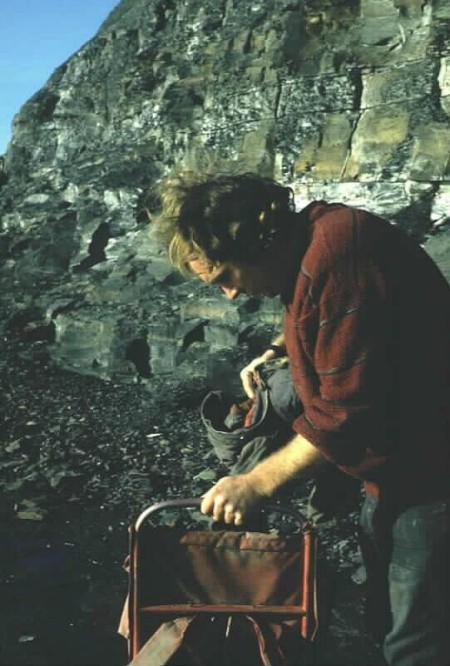
The Langhams
Stuart invited me to go down to Charmouth on a fossiling trip with a couple of friends - Bob and Peter Langham. Peter was much the same age as Stuart, and Bob his father. Bob had to most amazing collection of fossils - one the finest in private hands in the country. He has been collecting since the early 1960's, a time when many of the sites now well known and over-exploited had hardly been touched. Peter has been collecting since he was six years old, and has the best eye for finding fossils of anyone I have ever met. We were collecting at Kimmeridge one day, walking across the reef.
"Fish," Peter said, and waved his hand vaguely.
"Where?"
"It's no good. It's full of calcite."
"Where is it?"
He showed me. 20 feet away, the tiny corner of a scale, a black shiny speck the size of my fingernail showed on edge of a shallow, barely discernible bulge on the surface of the reef.
"How do you know it's full of calcite?"
He brought his hammer down in a crisp, sharp blow and the surface of the mound spalled away. The fish was no more than a ring of fragmented scales around a hole filled with calcite crystals.
"How did you know?"
He shrugged and walked on.
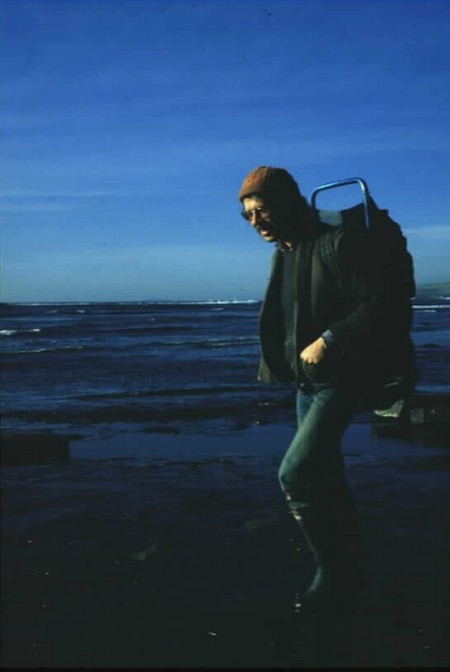
Bob's house in Reading was full of fossils. Every room had boxes on every surface, and in his living room the finest were on display I cases or wall-mounted. I went on several trips to Charmouth and Lyme with Stuart and the Langhams, and learned a vast amount simply by being with them. I was at University, and most of trips were at Christmas and Easter when bad weather and low tides expose more of the foreshore on the Dorset coast. Most of our collecting was at Charmouth and Lyme, with occasional excursions to Kimmeridge Bay and the Isle of Purbeck.
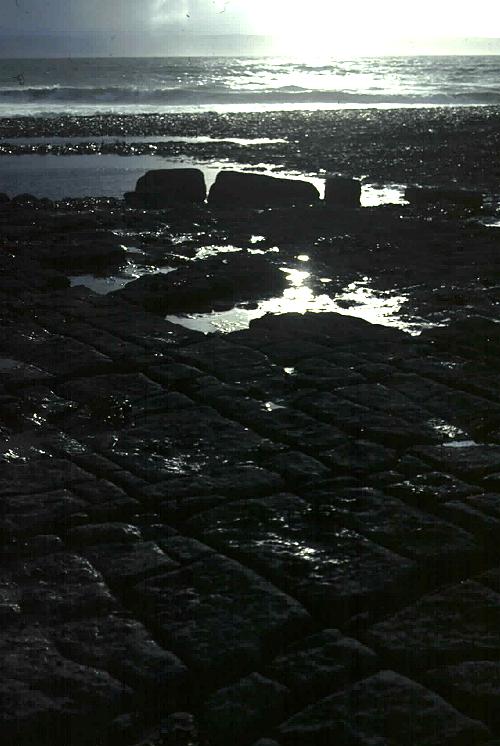
I built up a small collection of fossils - mainly ammonites, and a few odds bits of bone, but was keen to expand my knowledge of the subject. I read every book I could find, though the range provided by my local library was a bit limited. Most books on fossils were far to general (and inaccurate) to be of much use in finding collecting sites, and of limited use in identification, a situation not much different today. I have always been fascinated by maps, and noticed that the geological map of Southern England showed a great expanse of brown marking the Lower Lias on the Somerset coast, where I had found my first ammonite. I asked Stuart about it.
"No point in going there," he told me. "there's nothing there. Nobody bothers to go there."
Stolford
Friends of mine lived in Somerset at the time, and I hitchhiked down there one week in the summer to stay with them. With the geological map and ordnance survey maps of the coast I set myself the goal of exploring the coast, and pinpointed the tiny hamlet of Stolford as being the most eastern extreme of the exposure. So I borrowed a bicycle and cycled the few miles there.
The foreshore at Stolford is hidden from the land by a dyke. A lot of the land in that part of Somerset is below sea level. When I came to the top of the bank my heart sank. Most of what I could see was great expanses of mud, with a little exposed rock near the shore, and a low island of rock a hundred yards or so offshore. So I trudged through the fine, silty mud to the island. It began to rain. The mud stank. The Liassic strata along the Somerset coast are very distorted by earth tectonic movements, and in some places form regular waves no more than a few meters from crest to crest. Where the top of the wave has eroded away, the exposed shales stick out of the silty mud.
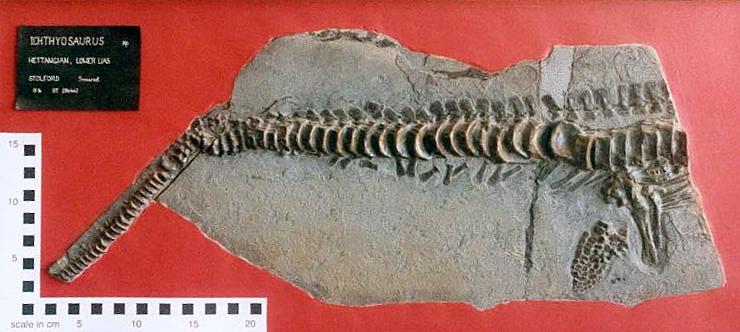 On one of these exposures I found a large piece of fossil wood, beautifully marked with the pattern of its' bark. This gave me hope. Further out the strata levelled out, and seaweed growing on the more solid substrates helped keep it clear of mud. I spotted a neat line on of seaweed, a place where the holdfasts of the bladderwrack had found solid anchorage on the underlying reef. Looking more closely, I realised that the anchorage was a row of articulated vertebrae. In growing excitement, I cleared the weed away. I had found half an ichthyosaur. I could see that the head end was missing. The slab of shale where the body had been preserved a faint, worn outline of ribs and vertebral column, and the head slab was gone completely. A small fragment of the front paddle which was more deeply buried was all that remained of the front end of the animal. The back - from the a little in front of the pelvic girdle back - was still encased in the shales. By now the tide was coming in, and I worked as quickly as I could to extract the specimen before the place was flooded. It came out in three large slabs.
On one of these exposures I found a large piece of fossil wood, beautifully marked with the pattern of its' bark. This gave me hope. Further out the strata levelled out, and seaweed growing on the more solid substrates helped keep it clear of mud. I spotted a neat line on of seaweed, a place where the holdfasts of the bladderwrack had found solid anchorage on the underlying reef. Looking more closely, I realised that the anchorage was a row of articulated vertebrae. In growing excitement, I cleared the weed away. I had found half an ichthyosaur. I could see that the head end was missing. The slab of shale where the body had been preserved a faint, worn outline of ribs and vertebral column, and the head slab was gone completely. A small fragment of the front paddle which was more deeply buried was all that remained of the front end of the animal. The back - from the a little in front of the pelvic girdle back - was still encased in the shales. By now the tide was coming in, and I worked as quickly as I could to extract the specimen before the place was flooded. It came out in three large slabs.
I wrapped them carefully in my coat, strapped them into my rucksack and wadded through mud and the rising tide, now well over the tops of my boots, back to dry land. By the time I had cycled back to my friends house, I was chilled to the bone, soaked to the skin, but elated. I hitchhiked back home the following day, the specimen now carefully wrapped in layers of newspaper and taped to strips of wood to keep them stable 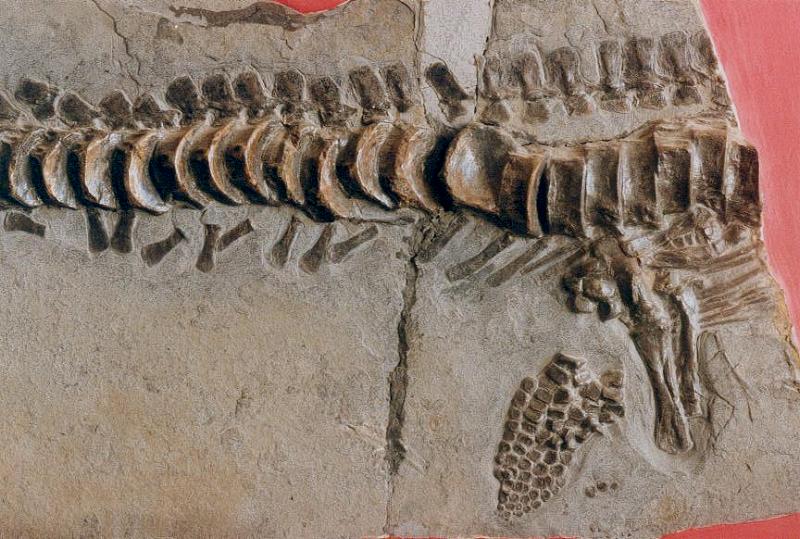 .
.
I called on Stuart, and we admired it together, then went off to Reading to show it to Bob Langham.
"Bit of a mess." He said. "you should have called us."
He took a closer look.
"I'll prep it for you if you want," he said.
Three weeks later it was ready.
"It's the best preserved bit of vertebrate material I've ever seen," he told me. They called me 'reptile' after that.
Marriage
Time passed, I finished my degree, I got married, we started a family. We moved to Luton. Diane came from Folkestone, and my fossil collecting became limited to afternoons on the Gault when we were visiting her parents. I started to study part-time to qualify fully as an architect, and time for collecting became a very rare commodity. I saw Stuart in tragic circumstances. His father died suddenly. It was the first time death had touched me so personally. Gulio was not old, and very much a friend.
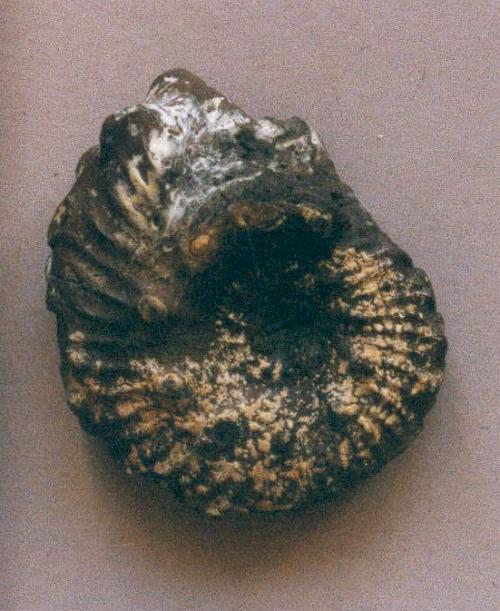
We had four children in five years.
17th December 1983.
Diane died.
Rebuilding my life
In the following year I struggled on the grim edge of raw survival. My sister and her husband came to look after the kids for a long weekend and give me a break. So I borrowed Richards's (my brother-in-law) XR3 and motored down to Charmouth at speeds rarely below the legal limit. Found a campsite, set up my tent, and found a pub.
Propping up the bar was Peter Langham. After the first couple of drinks we went off in search of Stuart, who by this time was in business with Peter collecting and selling fossils. Found him, and Bob Maurer in another pub, and the evening took its natural, alcoholic course 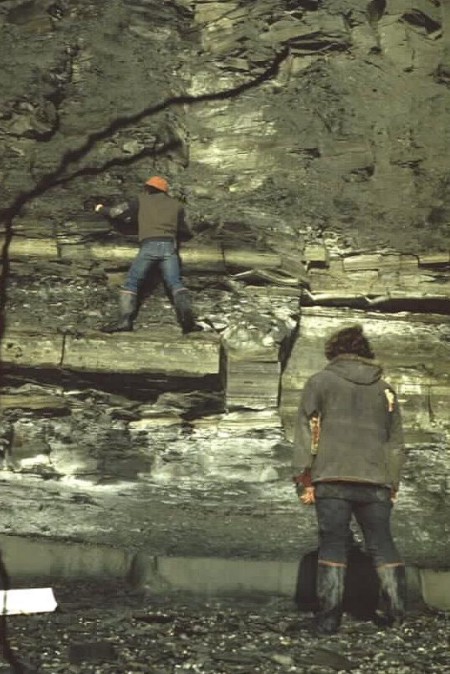 .
.
The next day, feeling grey and wan, I joined Stuart, Peter and Bob on a trip to Kimmeridge. We found a dinosaur. A good day.
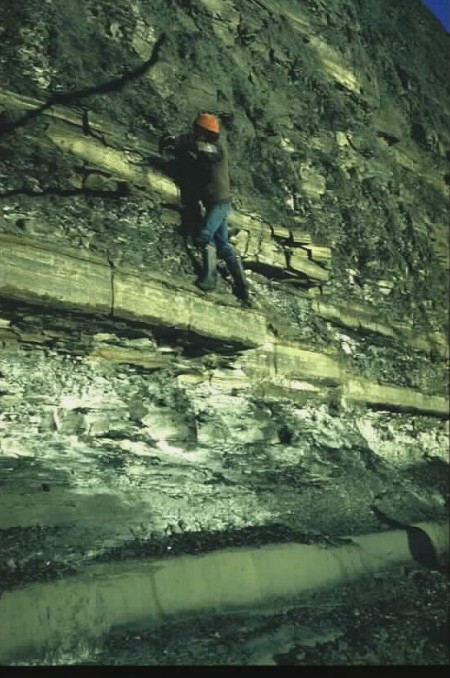
Stuart got married, much to my surprise.
Stuart
Heather, Stuarts mother, phoned me with bad news. Stuart was dead. I went down to Charmouth for the funeral, a tragic affair. Stuart had been worried about his weight, and had gone jogging. Being a bit embarrassed by it all, and not wanting to be recognised, he went out at night, dressed in a dark tracksuit. He was hit by a car and killed. The whole collecting community was shocked to the core. Stuart was liked and respected, and his death, following so soon after his marriage was a devastating blow to many people.
What was he like?
Bob Maurer described him well at his funeral. He called him ' a great bear of a man'.
Stuart and I once borrowed his mothers' mini to drive up to Yorkshire for a few days. On the way up we had a puncture. No jack. So Stuart lifted up the front of the car while I changed the wheel.
My mother always said that he had the face of a Botticelli angel - very Italian, in a blond Renaissance way. The trouble was, he cared nothing for looks. His clothes were usually torn by rocks,. He had the potential of being a fine athlete, but cared little for competition. He loved his fossils, the excitement of discovery, the wonder of being the first to see the relic of a creature that died a hundred million years ago or more.
Kettleness
Time passed, as it tends to do when you don't watch it carefully. I was working as an Architect for a practice in St Albans, and it was the peak of the boom of the 1980's. People though that property prices were going to double every year for ever, and would never fall. I was working on nine projects are the same time. I built office blocks, housing and leisure centres. It was hard work. It was exciting. It was fun 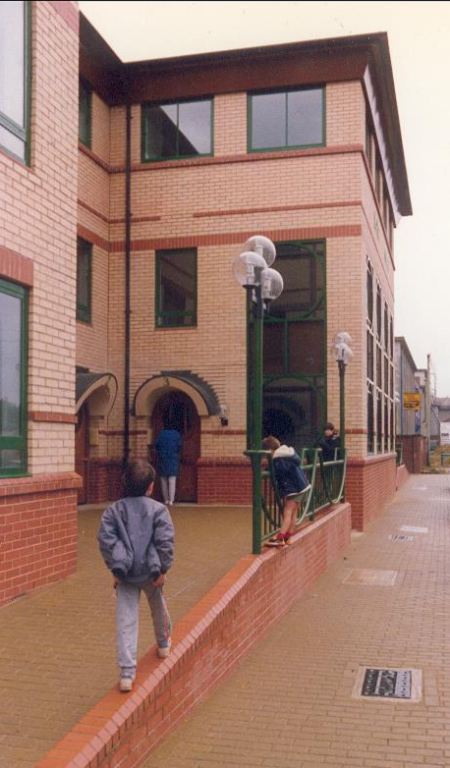 .
.
I remarried.
We had six children between us. The boom was slowing, and I thought that it was going to collapse in the South-East. We decided to move north.
I found a job in Nottingham.
Our daughter was born just before we moved into a huge Victorian house in Radcliffe-on-Trent.
The boom of the 1980's faded into the bust of the 1990's, and I was made redundant. I was out of work for two years.
I was fed up, frustrated, angry and worn out by rejection. So I drove up to Kettleness, and found an ichthyosaur. This time I prepared it myself. Missing the head, but a more or less complete vertebral column. It cheered me up considerably.  .
.
Dave Martill
I wanted to use some of the excessive spare time I had. The was an evening class on British Fossils in our local pub. It was run by someone I'd never heard of, Dr David Martill. 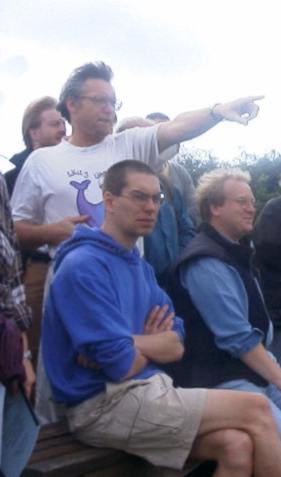 I was in that in-between stage of development as a palaeontologist , in which I knew more than most people, but had not yet realised the depth of my ignorance. Dave put me right. He has a great ability to communicate his own enthusiasm for the subject, and helped me put a lot of the fragmentary scraps of detailed knowledge I had collected over the years into a wider context. Things made more sense - the dots were being joined up, and a picture was starting to emerge.
I was in that in-between stage of development as a palaeontologist , in which I knew more than most people, but had not yet realised the depth of my ignorance. Dave put me right. He has a great ability to communicate his own enthusiasm for the subject, and helped me put a lot of the fragmentary scraps of detailed knowledge I had collected over the years into a wider context. Things made more sense - the dots were being joined up, and a picture was starting to emerge.
Germany
I was offered a job in Stralsund, on the north-east coast of the former East Germany because I speak good German. I was working for an English architectural practice based in Manchester, and spent the greater part of a year commuting each fortnight between Stralsund and Nottingham. Studying fossils took a back seat. The operation in Germany folded (I could write a book about that, but this is not the place). I worked on trying to win a project for the practise in St Petersburg, Russia, and had the chance to work in that fabulous city. The same day we won the contract they sacked me.
Ain't life a bitch.
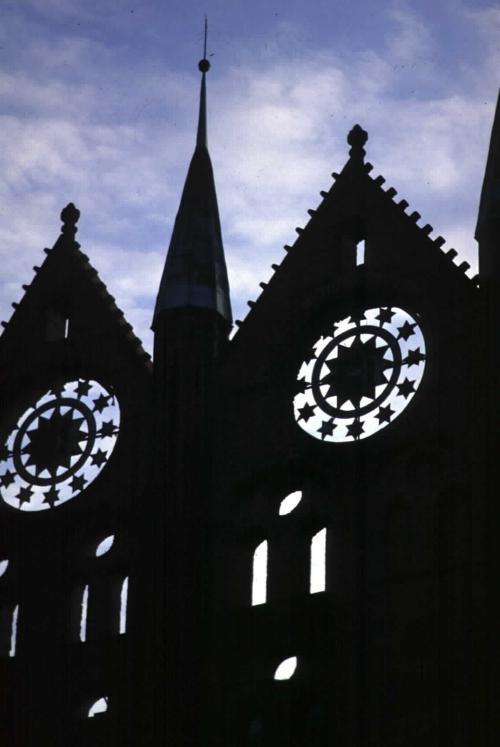
I had made good contacts in Germany, and tried to get work through them. Nobody would talk to me. There was a reason. I had been slandered badly by my former employers, but didn't have the resources to do anything about it. I was out in the cold. It was not a happy time.
So I withdrew into my shell, and wouldn't come out.
Arthur
The evening classes started up again. Dave Martill had moved on, and in his place they were being run by Dr Arthur Cruickshank. Someone else I'd never heard of (I really was pig-ignorant). Extinct mammals.
Arthur teaches in a way that assumes expertise, and you either keep up, or retire in confusion. After the third week he took me aside.
"You know more about this subject than most of my graduate student. You should be doing something with it."
So I started going into the Museum in Leicester every Friday. I still do. Initially the idea was that I should work on the structure of the plesiosaur skull. As an architect, Arthur assumed that I knew something about structures. Not an assumption any engineer would make, but valid in my case - I was a great irritation to most of the engineers I worked with because I would check their calculations and point out the errors. More to the point, I understand that engineers are good at telling you what to do to stop a building falling down, but less good at telling you why a building is still standing. We tried to get a project going with engineering department at Leicester University using finite element analysis to explore the structure of pliosaur skulls, but failed to find the funding, or get access to the computers needed for the complex calculations.
Muraenosaurus
So Arthur pointed me at some drawers in the fossils store.
"I think there's a plesiosaur in there. If you stick all the bits together, it might be a reasonable specimen, and by the time you've finished you'll have learned a lot about plesiosaur anatomy."
The specimen has been put into storage during WWII, and apparently thrown into a sack. The bones had been shattered, and were now a complex three-dimensional jigsaw, with no picture, and no assurance that the puzzle was complete. I started with over 3000 fragments, and over the next two years transformed them into 350 recognisable bones. In the process I learned one hell of a lot about plesiosaur anatomy.
Problems with necks
I had a problem.
Plesiosaurs have long necks. I had 72 vertebrae, and didn't know how to arrange them in the correct order. Some sorting can be done on a morphological basis - cervical, pectoral, dorsal, sacral and caudal can be identified. The problem lies in the detail. The centra vary in dimension in a rather complex way. I had measured gross dimensions of width, height and length, and tried to find a neat sequence. This proved not to be so simple. Depending on how I plotted the graphs, the sequence varied considerably. At the time our neighbours were the O'Hagans. Tony was then Professor of Statistics at Nottingham University ( he has since moved to Sheffield). I was talking about this problem over a glass (or two) of malt whisky one evening.
"Nice dirty data", he said, "just the thing for my students."
I went into Nottingham University a couple of week later with a collection of plesiosaur centra and a lot of numbers. I had measured everything I could think of - 27 dimensions and angles for each centrum.
 Bob Laxton, one of the researchers at Nottingham, took a particular interest. He suggested a method of statistical analysis, multi-variate analysis (also known as principal component analysis), as a tool for making sense of this great cloud of data points and went off with my numbers. We met in a pub a few weeks later to go over the results. They showed not only a neat sequence of centra, but also changes in the morphology of centra along the length of the neck. There seemed to be three distinct types.
Bob Laxton, one of the researchers at Nottingham, took a particular interest. He suggested a method of statistical analysis, multi-variate analysis (also known as principal component analysis), as a tool for making sense of this great cloud of data points and went off with my numbers. We met in a pub a few weeks later to go over the results. They showed not only a neat sequence of centra, but also changes in the morphology of centra along the length of the neck. There seemed to be three distinct types.
Cropwell Bishop
I thought I'd have a look at what they had in our local museum in Wollaton Hall, and found a plesiosaur it thought might be interesting because it was so much smaller than the Oxford Clay material I had been working on. It came from the Lias at Cropwell Bishop, a village three miles away from where I live. It had been donated to the precursor of the current museum in the 19th century.

So I borrowed it, and took it to Leicester to study. After measuring the vertebral centra, and much other research, I formed the opinion that it is an early elasmosaur.
SVPCA
I attended my first SVPCA in Derby in 1997. There I presented two papers, one on the multivariate analysis of the Muraenosaurus centra, the other on the Cropwell Bishop elasmosaur. It was an event I enjoyed immensely. I later published my first paper on the Cropwell Bishop specimen (Forrest 1998; A possible early elasmosaurian plesiosaur from the Triassic/Jurassic boundary of Nottinghamshire; Mercian Geologist, Vol 14, Issue 3, pp 135-143).
I have attended every SVPCA since then, and talked at most of them. 
Computers
I have worked with computers for a long time. When I was at University I wrote a programme which was entered into what was then a state-of-the-art machine on punched card. I owned one of the first home computers ever sold - the Sinclair ZX80, then available only in kit form. It had 1k of memory. I now work on a machine with a gigabyte of memory.
I applied for over 300 architectural jobs, and had had only one interview. I talked to a friend of mine who ran a practice in Nottingham at the time.
'You're too old and too much of a threat' he told me. 'The last thing any partner wants is someone who can do a better job than they can. They can get an architect fresh out of college and pay them much less than they'd have to pay you.'
'But that's not comparable. I bring far more than that.'
'That's not the way they think.'
No wonder architecture is going down the drain.
So I went back to college at the age of 43 and studied Business Management. On the course I found that I knew far more about computers than any of my fellow students, and more than most of the people teaching us IT. After I finished the course I started my own business, CBRP Ltd, helping small businesses with computers. That's how I earn my living these days. In the early days I spent most of my time building databases. Now I spend most of my time building web sites.
Bite Marks
I went with a friend to collect from Orton Pit before it was closed down, and found a fragment of plesiosaur girdle. When I cleaned it, I found marks from large teeth on it. I had found similar marks on one of the propodial of the Muraenosaurus I had worked on, and wondered just how common they were.
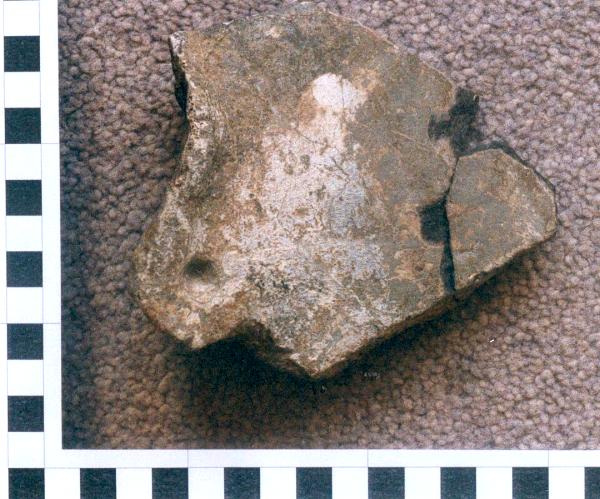
Leicester Museum has a good collection of plesiosaur material mainly from the Oxford Clay and the Lias, and bits and pieces from other formations. I spent a day looking through the collection, and found that more than half the limb bones had bite marks on them. It was an obvious move to study them in more detail, and I built a database to record various parameters of the marks: size, location, type, element, etc. I found variations in frequency, type and location between different Oxford Clay taxa (from which I had a dataset large enough to give statistically meaningful results) and presented this at the SVPCA in Bournemouth in 1998.

Databases
Tracy Ford sent us an exhaustive compendium of Sauropterygian references.
I started to think about databases, and built one from his records. Then I added to it, expanded it, re-ordered it, re-thought it and it became a web site. It uses all sorts of sophistry to write HTML pages from SQL data. I'm rather proud of it. I set the site up three years ago, and have re-written it in the last year. It takes a long time because I have to fit it around earning a living and trying to keep up some momentum on my research. I hope that people see it as a model for other sites. I want to be heavily criticised - how else can it be improved?
Plesiosaurs
'My' Muraenosaurus is on display in the museum.
Leaning on the rail and looking at it I realise why I am so fascinated by plesiosaurs. They are counterintuitive. They don't make sense as aquatic animals. How can a creature swim with a long neck held out in front of its' body? Hydrodynamic nonsense. I think of the mounted Thallasomedon in New York, with its' neck, all 68 vertebrae, stretching out over the gallery. A ridiculous animal. It doesn't make sense
Yet they did make sense. They dominated the marine environment for a hundred million years. Whatever they were doing, they were doing it very well. Plesiosaurs are unlike any modern animals. They have no descendants, and there are no modern analogues. I know that there is a piece missing from the picture. Something we can't see that makes the living, breathing animal work as an efficient predator. It may be an aspect of behaviour, or soft tissues, or even something that has been staring us in the face for two hundred years which nobody has noticed yet.
That's what feeds the fascination.